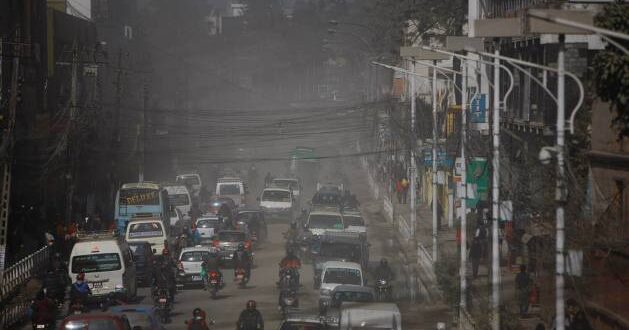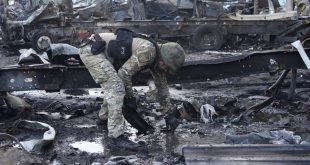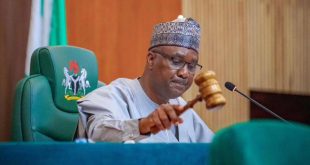KATHMANDU, Dec 02 (IPS) – The worldwide pandemic hijacked 2020 and reset priorities, however nations now have to regroup and renew their dedication to cap international warming at nicely beneath 2°C above pre-industrial ranges, as agreed in Paris in 2015.
On 12 December, it will likely be the fifth anniversary of the signing of the landmark local weather accord when 196 nations, together with Nepal, will likely be presenting their Nationally Determined Contributions (NDCs) to cut back the influence of the local weather disaster.
NDCs are voluntary commitments by nations to cut back their carbon footprints, however there are fears that a world within the throes of a Covid-19 induced financial disaster will observe by means of on previous commitmentswhilst scientists warn that the earth is warming way more quickly than forecast 5 years in the past in Paris.
The Himalaya is literally a hotspot as a result of the mountains are warming quicker than the worldwide common. However activists say Nepals personal Enhanced NDC doesn’t go far sufficient in mitigating carbon emissions, or adapting to the influence of the local weather emergency.
The doc has been put up for public remark and is topic to revision. Its spotlight is that Nepal for the primary time mentions net-zero emission as a future objective.
However the doc doesn’t give a timeline to attain it, and solely says that the nation will formulate a long-term low greenhouse fuel emission growth technique someday subsequent 12 months.
Within the area, Bhutan has already declared itself carbon impartialthat means its forests take in greater than the CO2 it emits. China, liable for 28% of whole annual carbon emissions, just lately pledged peak emission earlier than 2030 and attain net-zero by 2060. President-elect Joe Biden as dedicated that the US, which contributes 15% of CO2 yearly, to zero carbon emissions by 2050, as have Japan, South Korea and the UK.
India, the fourth largest CO2 emitter globally, is lagging however has been investing closely in solar energy, and by setting targets to affect railways and phasing out diesel and petroleum automobiles by 2030.
Nepali activists say the nations NDC might have gone a lot additional to set practical agency pledges, since it’s ranging from such a low carbon base.
We might have simply set a goal of net-zero by 2050. In truth, we will obtain it by 2030 if we’re actually dedicated, says environmentalist Bhushan Tuladhar. Our emission is negligible, we’re a low-carbon financial system and have a lot cleaner sources of vitality like hydroelectricity at our disposal.
In 2014, a report confirmed that Nepals forest space had doubled in 25 years, and it absorbed half of Nepals whole emissions from burning fossil fuels. Nevertheless, one other report final 12 months confirmed that carbon emission was rising quicker than vegetation cowl, and frequent wildfires have been themselves pumping extra CO2 into the environment.
Manjeet Dhakal, adviser to the Least Developed International locations assist group on the UN Framework Conference on Local weather Change (UNFCCC) says: Im fairly assured we’ll obtain net-zero by 2050. However what’s vital on this dialogue is that, whereas we could also be among the many smallest emitters, our emissions are rising and forests are usually not absorbing CO2 as they used to.
Nepals annual per capita carbon emission is likely one of the lowest on this planet at zero.29 tons. Compared, a median American pumps 16 tons of carbon yearly, and Qataris burn 37 tons. Nevertheless, Nepals per capita emission is rising considerably as a result of rising import of petroleum merchandise and thermal electrical energy from India.
As new roads are constructed and extra automobiles imported, Nepals essential driver of fossil gas consumption is the transportation sector. Bikes account for 80% of all automobiles in Nepal, and phasing them out for battery-powered two-wheelers would considerably scale back petroleum imports.
Electrical public transport will want subsidies from the federal government and buyers but it surely additionally means utilising Nepals clear vitality from hydropower and additional lowering our carbon footprint. Final fiscal 12 months, Nepals petroleum import reached Rs200 billion 2.2 instances increased than the nations whole earnings from exports. Imports of diesel, petrol, aviation gas and LPG went down barely in 2020 as a result of pandemic and lockdowns.
Switching to electric public transport and battery automobiles to cut back the petroleum import invoice by simply 10% would save Rs21 billion a 12 months. This may also clear up the air. Air air pollution killed 41,000 people in Nepal last year. This winter that threat for sufferers with respiratory points is mixed with Covid-19 problems.
Bishwo Nath Oli, Secretary on the Ministry of Forest and Surroundings agrees. We plan to provide 15,000MW of fresh vitality by 2030 and we want a method in order that it’s correctly consumed and utilised. Electrification of transport is one of the best ways to go about it, together with electrical stoves and biomass to chop emissions considerably.
Nepals Enhanced NDC has set a goal of turning 25% of all non-public passenger automobiles gross sales, together with two-wheelers, to electrical. It additionally goals to make 20% of all four-wheel public transport battery-powered by 2025. Most of Nepals three-wheel automobiles are already electrical.
Planners hope to extend these numbers to 90% and 60% by 2030. Equally, in 10 years Nepal goals to develop 200km of electrical rail community.
However activists are sceptical. Prime Minister KP Oli had declared in 2018 that 25% of all automobiles in Nepal can be electrical by 2020. Nevertheless, Finance Minister Yubaraj Khatiwada scrapped tax subsidies for electric vehicles on this 12 monthss funds, though his successor has restored some rebate for smaller battery-powered automobiles.
However even when these targets are met, they’re too conservative, says Bhushan Tuladhar. Our targets are sometimes too bold or too relaxed. With the brand new NDCs, we will see this sample in sectors resembling business, waste and agriculture that are both too obscure or too conservative, he provides.
Planners have additionally not taken under consideration that the price of electrical automobiles is already at par with diesel automobiles of the identical capability, and can decline additional as the worth of lithium-ion batteries continues to fall. Elevated affluence means extra individuals will go for two-wheelers and vehicles, almost certainly electrical, particularly as India and China section out manufacturing of diesel and petrol automobiles.
Whereas Nepals voluntary dedication units a goal to cut back coal consumption and air air pollution from brick and cement industries by 2030, it doesn’t point out how, and by how a lot. The NDC doc solely says the federal government will formulate pointers and set up mechanisms by 2025 to watch emissions from giant industries.
On the waste sector, the NDC says that by 2025, 380 million litres/day of wastewater will likely be handled earlier than discharge to pure programs, and 60,000 cubic meters/12 months of faecal sludge will likely be managed. Nevertheless it has focused solely 100 of Nepals 753 municipalities for waste segregation, recycling and waste-to-energy packages by 2030.
Nepals 2016 NDC pledged to extend forest cowl to 40% of the full space, and right here the nation exceeded the goal and present forest cowl stands at 44.74%. The brand new NDC has included extra group forests, and says 60% of Nepals space will likely be forest, pledging to cease deforestation of the Chure vary.
Equally, intercropping, agroforestry, conservation tillage and climate-smart agricultural technologies are all talked about within the NDC, however lacking conspicuously from the dialogue is farm mechanisation.
Nepal goals to increase hydroelectricity generation rom the present 1,400MW to 15,000 by 2030. Of this, 5,000MW is an unconditional goal, and the rest is contingent on funding from the worldwide group. In truth, Nepal will want $25 billion to satisfy its NDC targets, and most of this will likely be depending on international assist.
Manjeet Dhakal admits the targets within the new NDC will not be bold, however he says they’re practical. He provides: For the longest time Nepal was probably the most susceptible to local weather change. However time has come for us to point out our management and dedication to net-zero by implementing the targets set.
This story was originally published by The Nepali Instances
© Inter Press Service (2020) — All Rights ReservedOriginal source: Inter Press Service
 Top Naija News – Nigeria News, Nigerian News & Top Stories Top Naija News – Nigerian Newspapers, Nigerian News. topnaijanews is a daily Nigerian newspaper covering Latest News, Breaking News, Entertainment, Sports, Lifestyle and Politics.
Top Naija News – Nigeria News, Nigerian News & Top Stories Top Naija News – Nigerian Newspapers, Nigerian News. topnaijanews is a daily Nigerian newspaper covering Latest News, Breaking News, Entertainment, Sports, Lifestyle and Politics.




